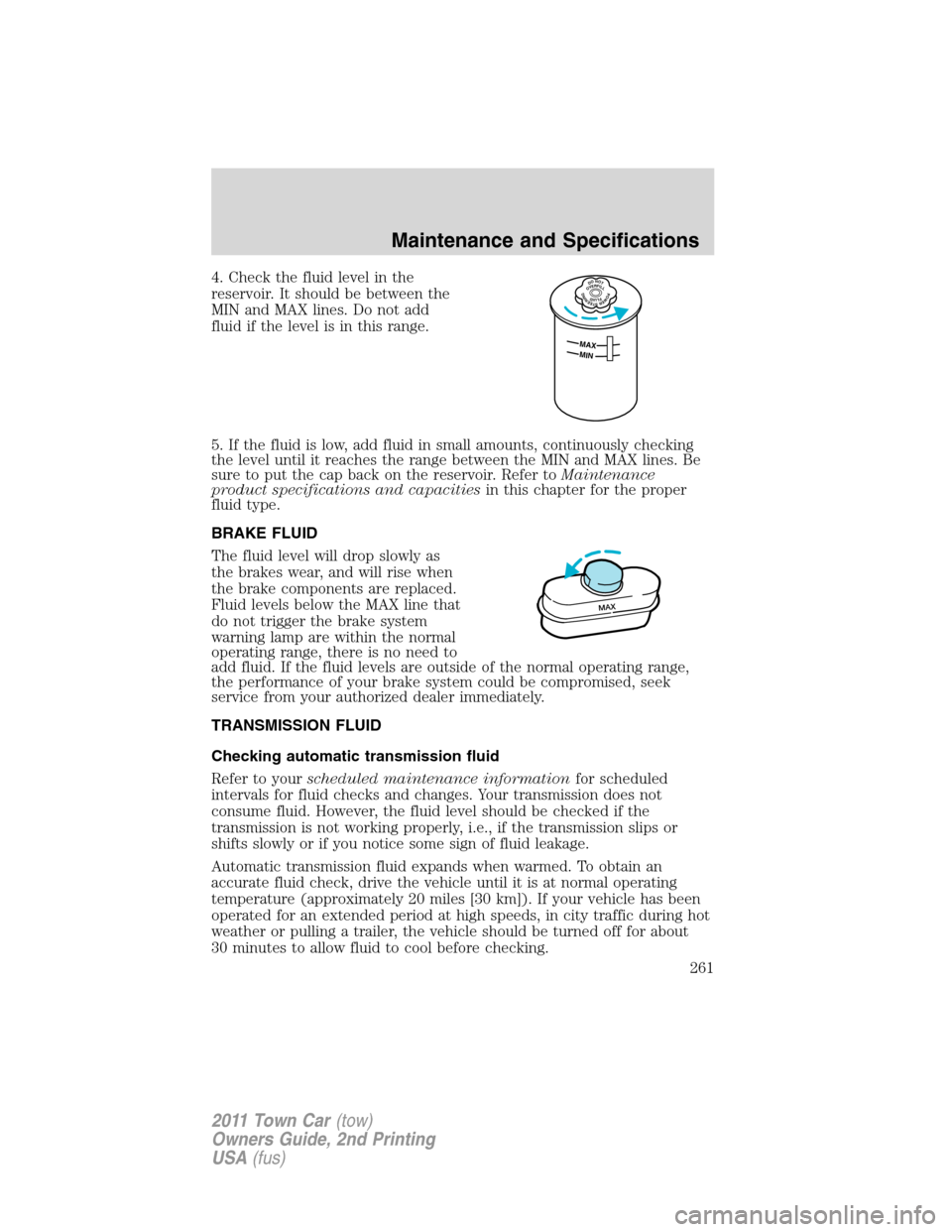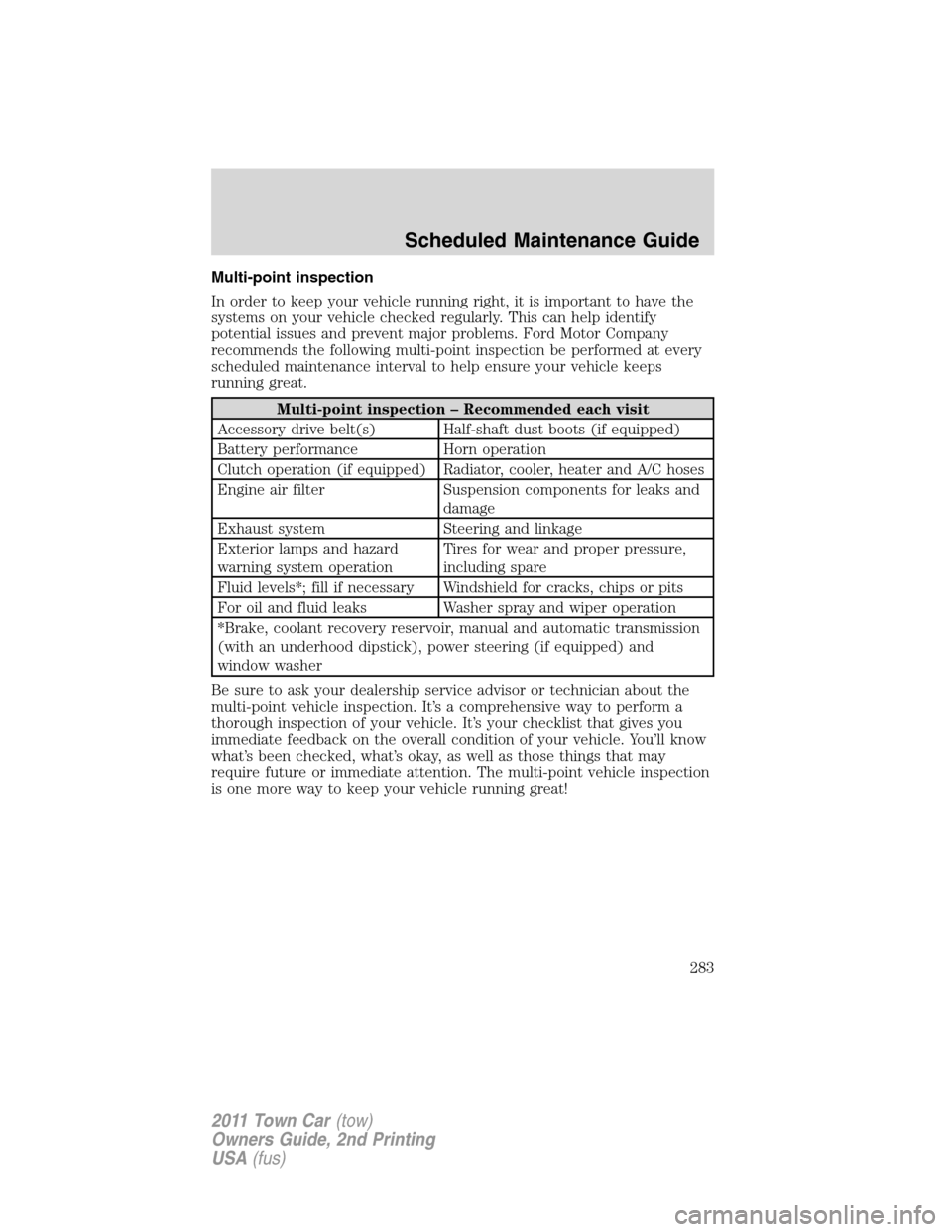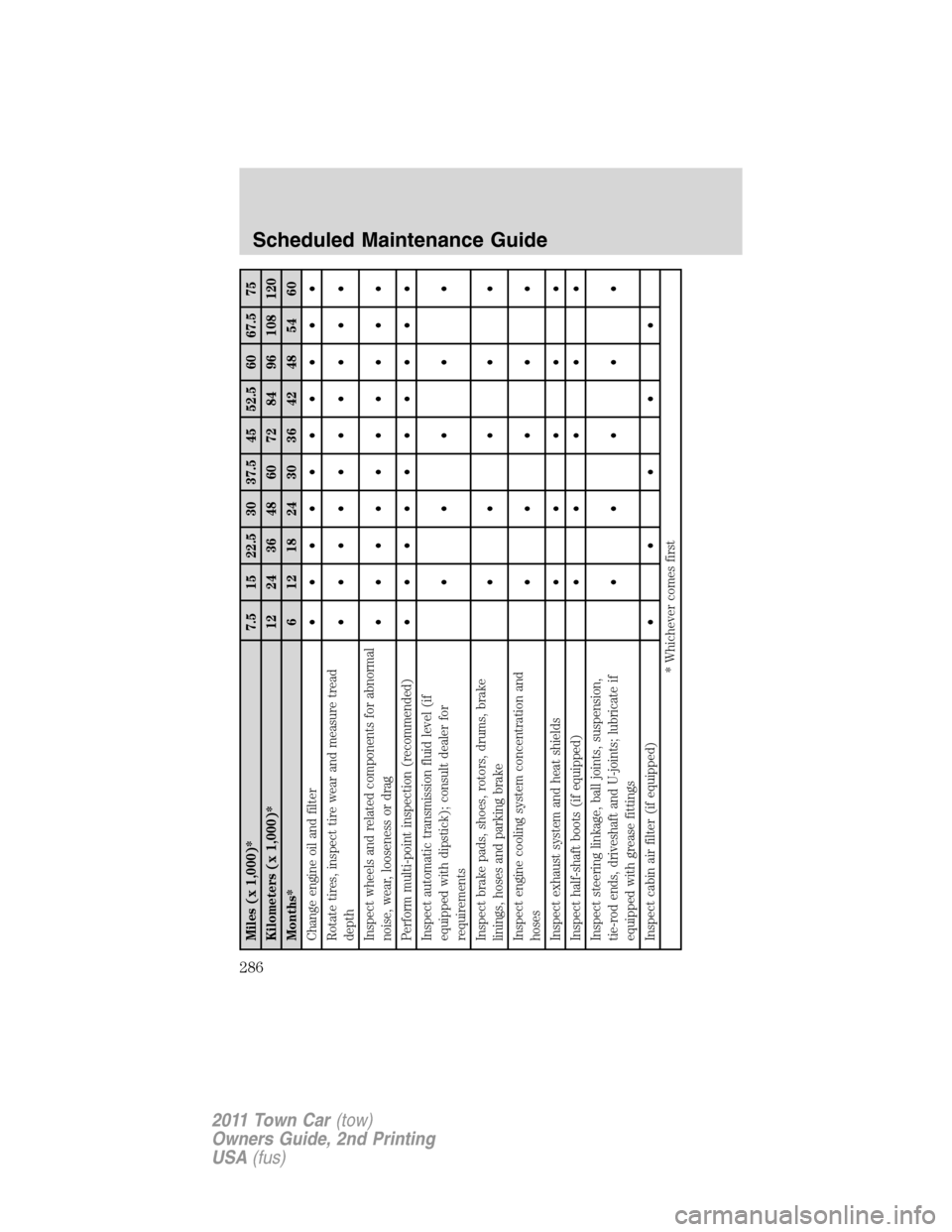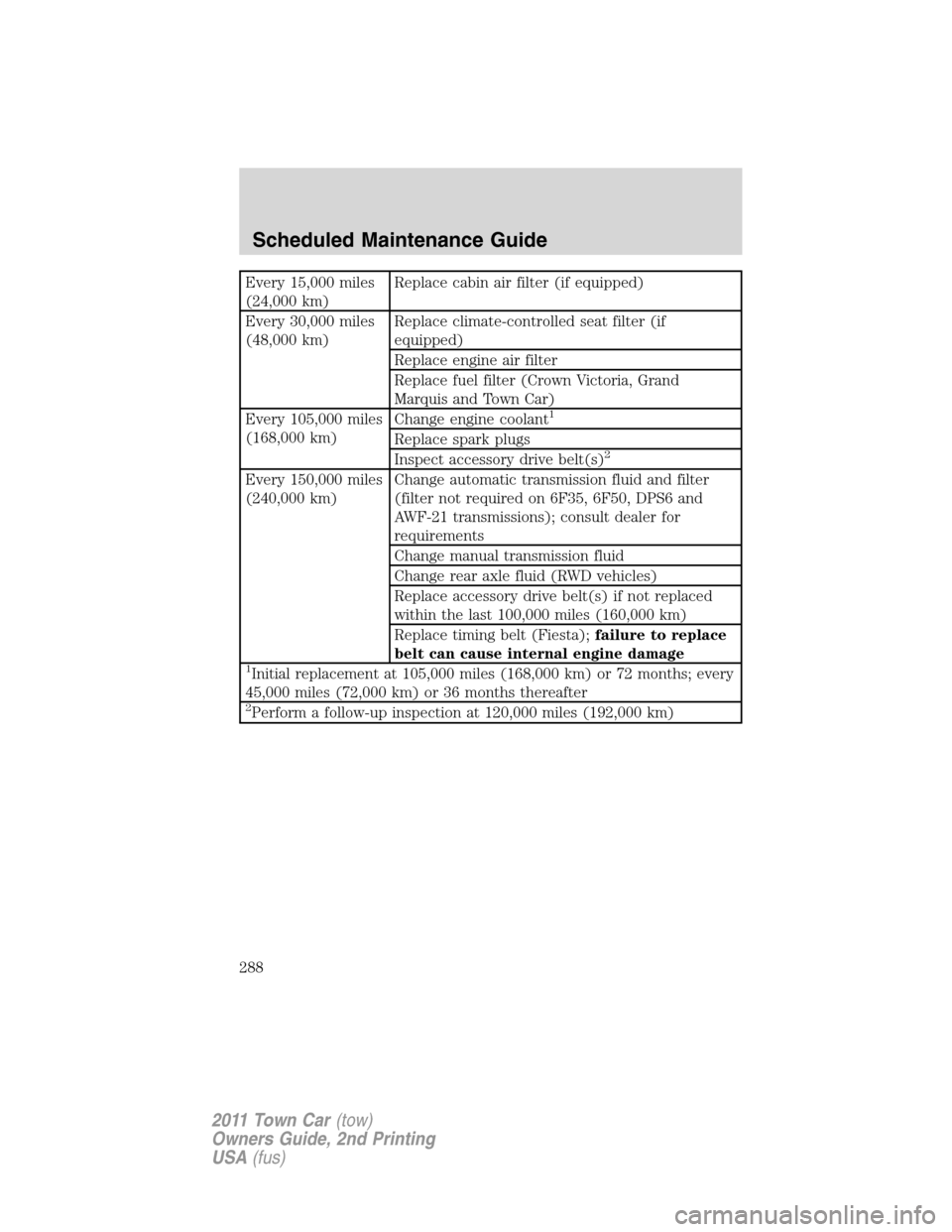Page 235 of 306
IDENTIFYING COMPONENTS IN THE ENGINE COMPARTMENT
1. Windshield washer fluid reservoir
2. Engine oil filler cap
3. Automatic transmission fluid dipstick
4. Brake fluid reservoir
5. Air filter assembly
6. Engine oil dipstick (access behind air tube)
7. Power steering fluid reservoir
8. Engine coolant reservoir
9. Power distribution box
10. Battery
Maintenance and Specifications
235
2011 Town Car(tow)
Owners Guide, 2nd Printing
USA(fus)
Page 261 of 306

4. Check the fluid level in the
reservoir. It should be between the
MIN and MAX lines. Do not add
fluid if the level is in this range.
5. If the fluid is low, add fluid in small amounts, continuously checking
the level until it reaches the range between the MIN and MAX lines. Be
sure to put the cap back on the reservoir. Refer toMaintenance
product specifications and capacitiesin this chapter for the proper
fluid type.
BRAKE FLUID
The fluid level will drop slowly as
the brakes wear, and will rise when
the brake components are replaced.
Fluid levels below the MAX line that
do not trigger the brake system
warning lamp are within the normal
operating range, there is no need to
add fluid. If the fluid levels are outside of the normal operating range,
the performance of your brake system could be compromised, seek
service from your authorized dealer immediately.
TRANSMISSION FLUID
Checking automatic transmission fluid
Refer to yourscheduled maintenance informationfor scheduled
intervals for fluid checks and changes. Your transmission does not
consume fluid. However, the fluid level should be checked if the
transmission is not working properly, i.e., if the transmission slips or
shifts slowly or if you notice some sign of fluid leakage.
Automatic transmission fluid expands when warmed. To obtain an
accurate fluid check, drive the vehicle until it is at normal operating
temperature (approximately 20 miles [30 km]). If your vehicle has been
operated for an extended period at high speeds, in city traffic during hot
weather or pulling a trailer, the vehicle should be turned off for about
30 minutes to allow fluid to cool before checking.DONOTOVERFILLPOWERSTEERINGFLUID
MAX
MIN
MAX
Maintenance and Specifications
261
2011 Town Car(tow)
Owners Guide, 2nd Printing
USA(fus)
Page 263 of 306
![LINCOLN TOWN CAR 2011 Owners Manual The transmission fluid should be in
this range if at ambient temperature
(50°F-95°F [10°C-35°C]).
High fluid level
Fluid levels above the safe range
may result in transmission failure.
An overfill LINCOLN TOWN CAR 2011 Owners Manual The transmission fluid should be in
this range if at ambient temperature
(50°F-95°F [10°C-35°C]).
High fluid level
Fluid levels above the safe range
may result in transmission failure.
An overfill](/manual-img/15/7054/w960_7054-262.png)
The transmission fluid should be in
this range if at ambient temperature
(50°F-95°F [10°C-35°C]).
High fluid level
Fluid levels above the safe range
may result in transmission failure.
An overfill condition of transmission
fluid may cause shift and/or
engagement concerns and/or
possible damage.
High fluid levels can be caused by an overheating condition.
Adjusting automatic transmission fluid levels
Before adding any fluid, make sure the correct type is used. The type of
fluid used is normally indicated on the dipstick. Refer toMaintenance
product specifications and capacitiesin this chapter.
Use of a non-approved automatic transmission fluid may cause
internal transmission component damage.
If necessary, add fluid in 1/2 pint (250 ml) increments through the filler
tube until the level is correct.
If an overfill occurs, excess fluid
should be removed by an authorized
dealer.
An overfill condition of
transmission fluid may cause
shift and/or engagement concerns and/or possible damage.
Do not use supplemental transmission fluid additives, treatments or
cleaning agents. The use of these materials may affect transmission
operation and result in damage to internal transmission components.
AIR FILTER
Refer toscheduled maintenance informationfor the appropriate
intervals for changing the air filter element.
When changing the air filter element, use only the air filter element
listed. Refer toMotorcraft�part numbersin this chapter.
Maintenance and Specifications
263
2011 Town Car(tow)
Owners Guide, 2nd Printing
USA(fus)
Page 269 of 306
Item CapacityFord part name or
equivalentFord part number / Ford
specification
Engine oil 6.0 quarts (5.7L)•Motorcraft�SAE
5W20 Premium
Synthetic Blend Motor
Oil (US)
•Motorcraft�SAE
5W-20 Full Synthetic
Motor Oil (US)
•Motorcraft�SAE
5W-20 Super Premium
Motor Oil (Canada)
•Motorcraft�SAE
5W-20 Synthetic Motor
Oil (Canada)
3
•XO-5W20-QSP (US)
•XO-5W20-QFS (US)
•CXO-5W20-LSP12 (Canada)
•CXO-5W20-LFS12 (Canada)
/WSS-M2C930-A with API
Certification Mark
Automatic
transmission fluid
(4R75E)13.9 quarts
(13.2L)
4
Motorcraft�
MERCON�LV AT F
5
XT-10-QLV /
MERCON�LV
Rear axle fluid
8
4.7-5.0 pints
(2.3- 2.4L)
7
Motorcraft�SAE
80W-90 Premium Rear
Axle LubricantXY-80W90-QL /
WSP-M2C197-A
4.5-4.7 pints
(2.1-2.3L)
6,7
Motorcraft�SAE
75W-140 Synthetic
Rear Axle Lubricant
(limousine)XY-75W140-QL /
WSL-M2C192-A
Maintenance and Specifications
269
2011 Town Car(tow)
Owners Guide, 2nd Printing
USA(fus)
Page 283 of 306

Multi-point inspection
In order to keep your vehicle running right, it is important to have the
systems on your vehicle checked regularly. This can help identify
potential issues and prevent major problems. Ford Motor Company
recommends the following multi-point inspection be performed at every
scheduled maintenance interval to help ensure your vehicle keeps
running great.
Multi-point inspection – Recommended each visit
Accessory drive belt(s) Half-shaft dust boots (if equipped)
Battery performance Horn operation
Clutch operation (if equipped) Radiator, cooler, heater and A/C hoses
Engine air filter Suspension components for leaks and
damage
Exhaust system Steering and linkage
Exterior lamps and hazard
warning system operationTires for wear and proper pressure,
including spare
Fluid levels*; fill if necessary Windshield for cracks, chips or pits
For oil and fluid leaks Washer spray and wiper operation
*Brake, coolant recovery reservoir, manual and automatic transmission
(with an underhood dipstick), power steering (if equipped) and
window washer
Be sure to ask your dealership service advisor or technician about the
multi-point vehicle inspection. It’s a comprehensive way to perform a
thorough inspection of your vehicle. It’s your checklist that gives you
immediate feedback on the overall condition of your vehicle. You’ll know
what’s been checked, what’s okay, as well as those things that may
require future or immediate attention. The multi-point vehicle inspection
is one more way to keep your vehicle running great!
Scheduled Maintenance Guide
283
2011 Town Car(tow)
Owners Guide, 2nd Printing
USA(fus)
Page 286 of 306

Miles (x 1,000)* 7.5 15 22.5 30 37.5 45 52.5 60 67.5 75
Kilometers (x 1,000)* 12 24 36 48 60 72 84 96 108 120
Months* 6 12 18 24 30 36 42 48 54 60
Change engine oil and filter• •••••••••
Rotate tires, inspect tire wear and measure tread
depth• •••••••••
Inspect wheels and related components for abnormal
noise, wear, looseness or drag• •••••••••
Perform multi-point inspection (recommended)• •••••••••
Inspect automatic transmission fluid level (if
equipped with dipstick); consult dealer for
requirements•••••
Inspect brake pads, shoes, rotors, drums, brake
linings, hoses and parking brake•••••
Inspect engine cooling system concentration and
hoses•••••
Inspect exhaust system and heat shields•••••
Inspect half-shaft boots (if equipped)•••••
Inspect steering linkage, ball joints, suspension,
tie-rod ends, driveshaft and U-joints; lubricate if
equipped with grease fittings•••••
Inspect cabin air filter (if equipped)• ••••
* Whichever comes first
Scheduled Maintenance Guide
286
2011 Town Car(tow)
Owners Guide, 2nd Printing
USA(fus)
Page 287 of 306

Miles (x 1,000)* 82.5 90 97.5 105 112.5 120 127.5 135 142.5 150
Kilometers (x 1,000)* 132 144 156 168 180 192 204 216 228 240
Months* 66 72 78 84 90 96 102 108 114 120
Change engine oil and filter• •••••••••
Rotate tires, inspect tire wear and measure tread
depth• •••••••••
Inspect wheels and related components for abnormal
noise, wear, looseness or drag• •••••••••
Perform multi-point inspection (recommended)• •••••••••
Inspect automatic transmission fluid level (if
equipped with dipstick); consult dealer for
requirements•••••
Inspect brake pads, shoes, rotors, drums, brake
linings, hoses and parking brake•••••
Inspect engine cooling system concentration and
hoses•••••
Inspect exhaust system and heat shields•••••
Inspect half-shaft boots (if equipped)•••••
Inspect steering linkage, ball joints, suspension,
tie-rod ends, driveshaft and U-joints; lubricate if
equipped with grease fittings•••••
Inspect cabin air filter (if equipped)• ••••
* Whichever comes first
Scheduled Maintenance Guide
287
2011 Town Car(tow)
Owners Guide, 2nd Printing
USA(fus)
Page 288 of 306

Every 15,000 miles
(24,000 km)Replace cabin air filter (if equipped)
Every 30,000 miles
(48,000 km)Replace climate-controlled seat filter (if
equipped)
Replace engine air filter
Replace fuel filter (Crown Victoria, Grand
Marquis and Town Car)
Every 105,000 miles
(168,000 km)Change engine coolant
1
Replace spark plugs
Inspect accessory drive belt(s)2
Every 150,000 miles
(240,000 km)Change automatic transmission fluid and filter
(filter not required on 6F35, 6F50, DPS6 and
AWF-21 transmissions); consult dealer for
requirements
Change manual transmission fluid
Change rear axle fluid (RWD vehicles)
Replace accessory drive belt(s) if not replaced
within the last 100,000 miles (160,000 km)
Replace timing belt (Fiesta);failure to replace
belt can cause internal engine damage
1Initial replacement at 105,000 miles (168,000 km) or 72 months; every
45,000 miles (72,000 km) or 36 months thereafter
2Perform a follow-up inspection at 120,000 miles (192,000 km)
Scheduled Maintenance Guide
288
2011 Town Car(tow)
Owners Guide, 2nd Printing
USA(fus)